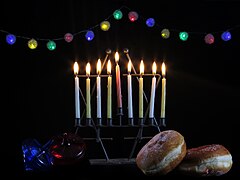| Hanukkah | |
|---|---|
 | |
| Official name | חֲנֻכָּה or חֲנוּכָּה English translation: 'Establishing' or 'Dedication' (of the Temple in Jerusalem) |
| Observed by | Jews |
| Type | Jewish |
| Significance | The Maccabees successfully revolted against Antiochus IV Epiphanes. According to the Talmud, the Temple was purified and the wicks of the menorah miraculously burned for eight days, even though there was only enough sacred oil for one day's lighting. |
| Celebrations | Lighting candles each night. Singing special songs, such as Ma'oz Tzur. Reciting the Hallel prayer. Eating food fried in oil, such as latkes and sufganiyot, and dairy foods. Playing the dreidel game, and giving Hanukkah gelt |
| Begins | 25 Kislev |
| Ends | 2 Tevet or 3 Tevet |
| Date | 25 Kislev, 26 Kislev, 27 Kislev, 28 Kislev, 29 Kislev, 30 Kislev, 1 Tevet, 2 Tevet, 3 Tevet |
| 2023 date | Sunset, 7 December – nightfall, 15 December[1] |
| 2024 date | Sunset, 25 December – nightfall, 2 January[1] |
| 2025 date | Sunset, 14 December – nightfall, 22 December[1] |
| 2026 date | Sunset, 4 December – nightfall, 12 December[1] |
| Related to | Purim, as a rabbinically decreed holiday. |

Hanukkah[a] (/ˈhɑːnəkə/; חֲנֻכָּה Ḥănukkā ) is a Jewish festival commemorating the recovery of Jerusalem and subsequent rededication of the Second Temple at the beginning of the Maccabean Revolt against the Seleucid Empire in the 2nd century BCE.[3][4]
Hanukkah is observed for eight nights and days,[5] starting on the 25th day of Kislev according to the Hebrew calendar, which may occur at any time from late November to late December in the Gregorian calendar. The festival is observed by lighting the candles of a candelabrum with nine branches, commonly called a menorah or hanukkiah. One branch is typically placed above or below the others and its candle is used to light the other eight candles. This unique candle is called the shammash (שַׁמָּשׁ, "attendant"). Each night, one additional candle is lit by the shammash until all eight candles are lit together on the final night of the festival.[6]
Other Hanukkah festivities include singing Hanukkah songs, playing the game of dreidel and eating oil-based foods, such as latkes and sufganiyot, and dairy foods. Since the 1970s, the worldwide Chabad Hasidic movement has initiated public menorah lightings in open public places in many countries.[7]
Originally instituted as a feast "in the manner of Sukkot (Booths)", it does not come with the corresponding obligations, and is therefore a relatively minor holiday in strictly religious terms. Nevertheless, Hanukkah has attained major cultural significance in North America and elsewhere, especially among secular Jews, due to often occurring around the same time as Christmas during the festive season.[8]
- ^ a b c d "Dates for Hanukkah". Hebcal.com by Danny Sadinoff and Michael J. Radwin (CC-BY-3.0). Retrieved 26 August 2018.
- ^ Miller, Jason (21 December 2011). "How Do You Spell Hanukkah?". The New York Jewish Week. Archived from the original on 25 May 2021. Retrieved 30 October 2021.
- ^ "What Is Hanukkah?". Chabad-Lubavitch Media Center.
In the second century BCE, the Holy Land was ruled by the Seleucids (Syrian-Greeks), who tried to force the people of Israel to accept Greek culture and beliefs instead of mitzvah observance and belief in G‑d. Against all odds, a small band of faithful but poorly armed Jews, led by Judah the Maccabee, defeated one of the mightiest armies on earth, drove the Greeks from the land, reclaimed the Holy Temple in Jerusalem and rededicated it to the service of G‑d. ... To commemorate and publicize these miracles, the sages instituted the festival of Chanukah.
- ^ – via Wikisource.
- ^ "01. The Mitzva to Light Ĥanuka Candles – Peninei Halakha". Retrieved 6 December 2023.
- ^ "How to Light the Menorah". chabad.org. Archived from the original on 5 June 2017. Retrieved 6 October 2018.
- ^ "JTA NEWS". Joi.org. Archived from the original on 6 October 2007.
- ^ Moyer, Justin (22 December 2011). "The Christmas effect: How Hanukkah became a big holiday". The Washington Post. Retrieved 30 December 2019.
Cite error: There are <ref group=lower-alpha> tags or {{efn}} templates on this page, but the references will not show without a {{reflist|group=lower-alpha}} template or {{notelist}} template (see the help page).